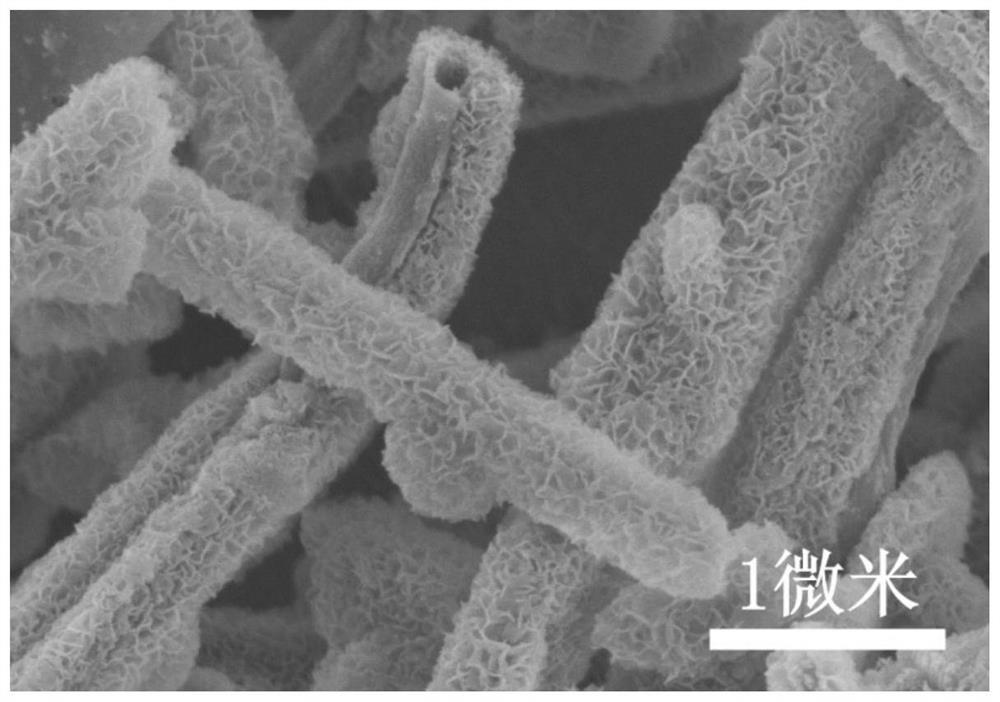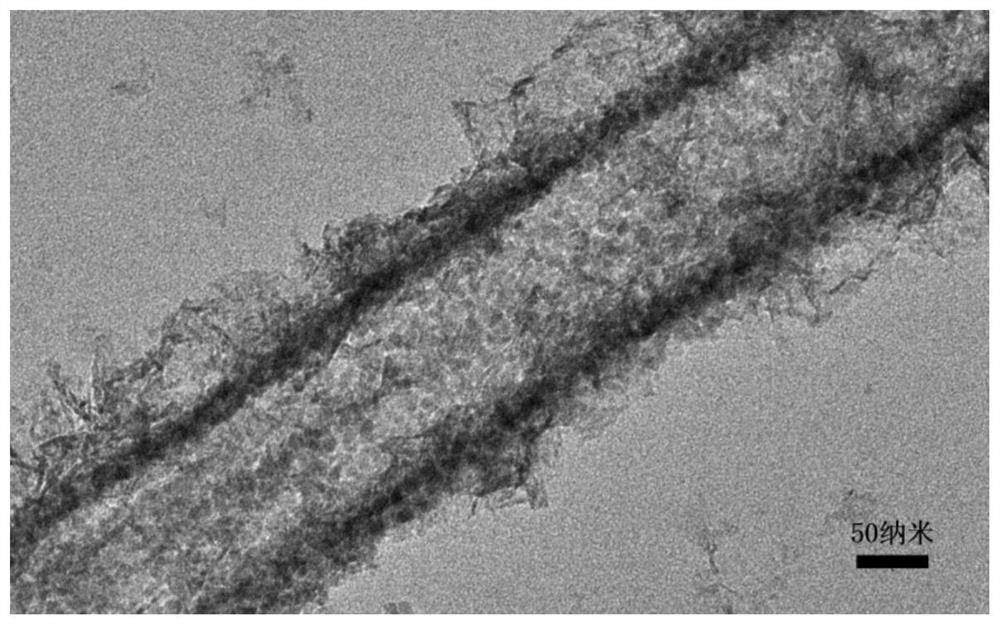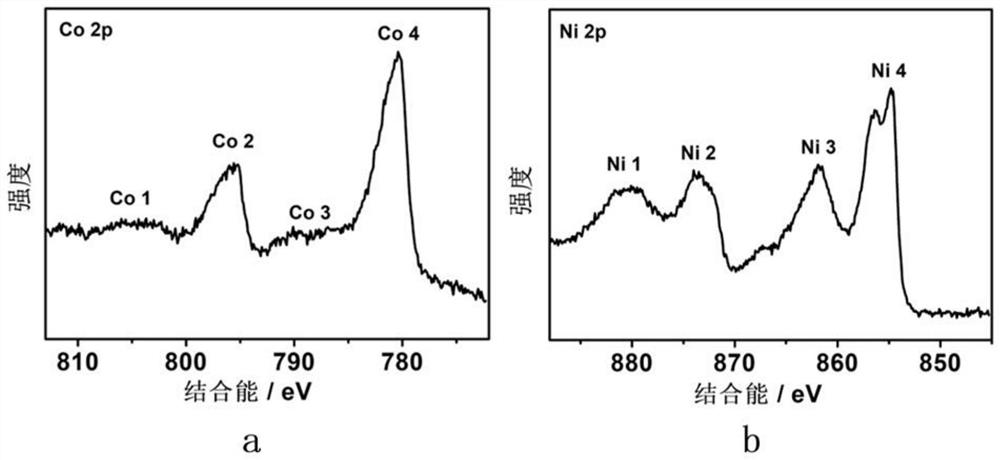Cobaltosic oxide-nickel oxide double-layer mesoporous nanotube composite material as well as preparation method and application thereof
A technology of tricobalt tetroxide and composite materials, applied in metal/metal oxide/metal hydroxide catalysts, chemical instruments and methods, nanotechnology, etc., can solve problems such as hindering electron/mass transfer and internal material utilization
- Summary
- Abstract
- Description
- Claims
- Application Information
AI Technical Summary
Problems solved by technology
Method used
Image
Examples
Embodiment 1
[0041] Step 1: Weigh 0.873g cobalt nitrate hexahydrate, 0.3993g L-aspartic acid in a 50mL polytetrafluoroethylene-lined stainless steel hydrothermal reaction kettle, and add 10mL deionized water and 18mL ethylene glycol to it, Add 3mL, 2mol / L sodium hydroxide solution under magnetic stirring, and stir magnetically at room temperature until the solution turns transparent reddish brown. Then transfer the reaction kettle to a 180°C electric blast drying oven and keep it for 5 hours. After the end, the pink solid is collected by centrifugation, and then washed with water and ethanol for four times, and finally placed in a vacuum drying oven at 40°C. Drying for 12 hours under the hood to obtain Co-Asp nanowires.
[0042] Step 2: Weigh 0.075 g of Co-Asp nanowires into a 100 mL beaker, add 20 mL of absolute ethanol therein, and stir to disperse the Co-Asp nanowires.
[0043] Step 3: Add 10mL (0.1mol L -1 ) ethanol solution of nickel nitrate hexahydrate, after mixing evenly, transfe...
Embodiment 2
[0046] Step 1: Weigh 1.746g cobalt nitrate hexahydrate, 0.7986g L-aspartic acid in a 50mL polytetrafluoroethylene-lined stainless steel hydrothermal reaction kettle, and add 10mL deionized water and 18mL ethylene glycol to it, Add 6 mL of 2 mol / L sodium hydroxide solution under magnetic stirring, and stir magnetically at room temperature until the solution turns transparent reddish brown. Then transfer the reaction kettle to a 180°C electric blast drying oven and keep it for 5 hours. After the end, the pink solid is collected by centrifugation, and then washed with water and ethanol for four times, and finally placed in a vacuum drying oven at 40°C. Drying for 12 hours under the hood to obtain Co-Asp nanowires.
[0047] Step 2: Weigh 0.075 g of Co-Asp nanowires into a 100 mL beaker, add 20 mL of absolute ethanol therein, and stir to disperse the Co-Asp nanowires.
[0048] Step 3: Add 10mL (0.1mol L -1 ) ethanol solution of nickel nitrate hexahydrate, after mixing evenly, tra...
Embodiment 3
[0051] Step 1: Weigh 0.873g cobalt nitrate hexahydrate, 0.3993g L-aspartic acid in a 50mL polytetrafluoroethylene-lined stainless steel hydrothermal reaction kettle, and add 10mL deionized water and 18mL ethylene glycol to it, Add 3mL, 2mol / L sodium hydroxide solution under magnetic stirring, and stir magnetically at room temperature until the solution turns transparent reddish brown. Then transfer the reaction kettle to a 180°C electric blast drying oven and keep it for 5 hours. After the end, the pink solid is collected by centrifugation, and then washed with water and ethanol for four times, and finally placed in a vacuum drying oven at 40°C. Drying for 12 hours under the hood to obtain Co-Asp nanowires.
[0052] Step 2: Weigh 0.150 g of Co-Asp nanowires into a 100 mL beaker, add 20 mL of absolute ethanol therein, and stir to disperse the Co-Asp nanowires.
[0053] Step 3: Add 20mL (0.1mol L -1 ) ethanol solution of nickel nitrate hexahydrate, after mixing evenly, transfe...
PUM
| Property | Measurement | Unit |
|---|---|---|
| Length | aaaaa | aaaaa |
| Diameter | aaaaa | aaaaa |
| Thickness | aaaaa | aaaaa |
Abstract
Description
Claims
Application Information
 Login to View More
Login to View More - R&D
- Intellectual Property
- Life Sciences
- Materials
- Tech Scout
- Unparalleled Data Quality
- Higher Quality Content
- 60% Fewer Hallucinations
Browse by: Latest US Patents, China's latest patents, Technical Efficacy Thesaurus, Application Domain, Technology Topic, Popular Technical Reports.
© 2025 PatSnap. All rights reserved.Legal|Privacy policy|Modern Slavery Act Transparency Statement|Sitemap|About US| Contact US: help@patsnap.com



